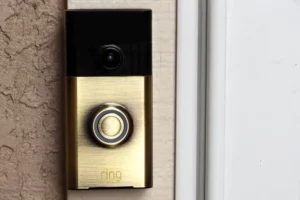Smart doorbells offer great convenience, allowing you to interact with visitors or delivery personnel via your smartphone when you’re away. Additionally, they provide motion recording capabilities to enhance security around your property. However, despite their benefits, certain flaws exist within many smart doorbell models. Battery-powered options often perform poorly compared to their hardwired counterparts, and some doorbells require a monthly subscription to access the most useful features. Among such options, Ring stands out as one of the worst offenders, in my opinion.
In light of these concerns, I’ve prepared this guide to delve into the advantages and disadvantages of various smart doorbells. Subsequently, I will suggest a selection of hardwired doorbells that don’t necessitate a monthly fee. These recommendations aim to provide reliable functionality without burdening you with ongoing costs.
Features of Smart Doorbells
I share your enthusiasm for smart doorbells, as they indeed offer valuable benefits in our busy modern lives. The ability to communicate with visitors or delivery personnel through two-way talk on our mobile phones, even when we’re away from home due to work, school runs, or outings, is undeniably a handy feature.

Moreover, the security aspect of smart doorbells is appealing. Their ability to record activities within a specific area around the doorbell contributes to property monitoring while we are not present. This can potentially act as a deterrent against criminal activities, although the actual impact on reducing crime is a subject of debate between companies like Ring, which claim such benefits, and some American police who dispute these claims.
Beyond their practicality, smart doorbells are energy-efficient, often easy to install, and offer a range of useful features. However, there are trade-offs to consider:
The simplest installation method is choosing a battery-powered smart doorbell, as it avoids messing with your home’s electrical system. However, the reliance on batteries can limit the device’s performance to preserve battery life. For instance, certain battery-powered doorbells, like Ring’s, may offer fewer motion-detection features compared to their hardwired counterparts.
While smart doorbells provide numerous impressive features, they come with associated costs. The operation of “the cloud” infrastructure, which facilitates features like remote access and data storage, incurs expenses. As a result, many smart doorbell manufacturers charge monthly fees to access the most valuable features, such as snapshot captures and people-only detection.
Before delving into methods of acquiring a useful smart doorbell without burdensome monthly fees, I would like to highlight why I always recommend wired smart doorbells over their battery-powered counterparts.
Why Should You Consider Wired Doorbells?
You are absolutely right that installing a wired doorbell may involve more effort and considerations, such as the need for a resistor or whether you can reuse your existing wall chime. However, despite these initial complexities, if possible, opting for a hardwired smart doorbell is highly recommended for various compelling reasons.

One significant advantage of a wired doorbell is that you won’t have to worry about the battery running out and the inconvenience of frequent recharging, especially in very cold climates where battery performance can be affected. Since the doorbell receives continuous power, it can utilize its full array of features and motion-detection capabilities effectively. For instance, certain wired Ring devices now come with 3D radar technology, offering advanced motion-detection features that surpass what can be achieved with battery-operated devices.
Furthermore, wired doorbells can conduct more on-board software processing compared to battery models, leading to several benefits:
- Improved audio performance during interactions with visitors, resulting in clearer and less distorted conversations.
- Smarter alerts that specify the trigger of the motion alert, whether it’s caused by an animal, a car, or a person.
- Enhanced configuration options for precise motion zones, allowing you to define specific areas where the doorbell should detect motion, disregarding any activity outside those zones.
If you already have doorbell wiring in place, the installation process should be relatively straightforward: just remove your old doorbell and replace it with the new one. Occasionally, you might require a new transformer, so it’s essential to double-check this aspect.
However, even if you lack pre-existing wired doorbell wiring, all hope is not lost. You can sometimes purchase a plug-in adapter, which enables you to run a cable to your wired doorbell location and plug it into a wall socket. While this method adds some extra work compared to installing a wireless, battery-based doorbell, it provides a feasible solution for enjoying the benefits of a hardwired setup without a major hassle.
In conclusion, the advantages of a hardwired smart doorbell, such as consistent power, enhanced features, and better performance, outweigh the initial complexities involved in installation. If possible, opting for a wired doorbell can be a valuable investment in terms of convenience and functionality for your smart home setup.
Best Wired Doorbells Without Subscriptions
Here’s a detailed overview of several well-known smart doorbell brands and how they function without requiring a subscription:
Eufy Wired Doorbells: Eufy offers doorbells with local storage capabilities. You have the choice to store recordings either on the device itself (local storage with 4GB built-in) or to the cloud with a subscription that costs $3 per month or $30 per year per camera. The majority of features work without a subscription, thanks to the local storage option. However, one drawback is the lack of expandable SD card support, resulting in limited storage capacity. Without a subscription, the doorbell can only store a half month’s worth of recordings, after which the oldest recordings get deleted. Nevertheless, Eufy provides rich notifications for free, unlike some competitors.
Buy from Amazon- Eufy Wired Doorbells
Arlo Doorbell: Arlo offers a 3-month trial of Arlo Secure subscription services, which include cloud storage, object detection, and activity zones. After the trial, a subscription is required to maintain these features. Without a subscription, you lose essential functionalities, such as recording, enhanced notifications, and motion detection configuration. Arlo Doorbell without a subscription is limited to live view mode and basic motion and doorbell-press alerts. However, Arlo does offer a theft protection feature for free, replacing the doorbell if stolen once.
Buy from Amazon- Arlo Doorbell
Ring Doorbells: Similar to Arlo, Ring loses several features without a Ring Protect subscription. Without a subscription, you will not receive snapshot captures, and all recordings are inaccessible. Ring Doorbells also lack object detection and customizable motion zones without a subscription. However, Ring still covers theft protection, replacing the doorbell once for free if stolen.

Buy from Amazon- Ring Doorbells
Wyze Doorbell: Wyze used to provide cloud storage of recordings without a subscription but changed their policy in 2022, now requiring a $1.99 monthly Cam Plus subscription for cloud storage. Without a subscription, you only receive a still image of motion events, and local storage support for doorbells is unavailable, making free usage less appealing.
Buy from Amazon- Wyze Doorbell
Nest (Google) Doorbell: Nest offers advanced features backed by Google’s powerful image and video recognition capabilities, but most of these features are available only with a subscription. The Nest Doorbell does provide 3 hours of motion-based recording clips without a subscription, which sets it apart from Ring and Arlo. Still, without a subscription, you miss out on various features, making it more suitable to either choose a subscription or consider alternative options.
Buy from Amazon- Nest (Google) Doorbell
Reolink Doorbell: Reolink’s doorbell supports power over Ethernet (PoE), providing a stable connection. Reolink believes in no subscription fees and focuses on local storage to an SD card, a local NAS, or a Reolink DVR (sold separately). The doorbell works quite well without a subscription, with no mandatory cloud plan. However, rich notifications are not available without a subscription, and Google Home support might be unreliable.
Buy from Amazon- Reolink Doorbell
Amcrest Doorbell: Amcrest’s doorbell supports local storage via an SD card but lacks the ability to view recordings via the phone app. Without a subscription, you can still receive motion and doorbell-press notifications, but accessing recordings requires removing the SD card and transferring the videos to a computer. This makes local storage a bit clunky, and a subscription may be more appealing for cloud storage.
Buy from Amazon- Amcrest Doorbell
Netatmo Doorbell: Netatmo’s doorbell is HomeKit-enabled, offering no subscription fees and allowing local storage on an SD card. Recordings can also be backed up to FTP or Dropbox. The doorbell is hardwired, has no battery, and can ring your existing chime unit even if internet connection is lost. It supports both 2.4 GHz Wi-Fi and Alexa compatibility.
Buy from Amazon- Netatmo Doorbell
Lorex Doorbell: Lorex is similar to Eufy in offering no monthly fees and emphasizing local recording. The doorbell comes with a 32GB WD microSD card, supporting up to a 256GB card for ample storage. Unlike Amcrest, you can view local recordings through the app. Lorex provides customizable motion zones and sends phone notifications without requiring a subscription, making it a good budget option. It also supports Alexa integration.
Buy from Amazon- Lorex Doorbell
Wrapping it up
Based on your hands-on testing and research, you have identified three clear winners among wired doorbells that work well without requiring a subscription:
These three options stand out as they offer robust functionalities without the need for a monthly subscription, making them appealing choices for users who wish to avoid ongoing fees.
In terms of app performance, Eufy’s products and phone app appear to be the most polished among the three, with a high rating of 4.7/5 on the Google Play store. Reolink’s products are reliable, but the app may have some occasional clunkiness, resulting in a rating of 2.7/5 on the Play store. Lorex is a newcomer to the smart doorbell scene but has a well-reviewed app and offers a promising product.
The quality of the app is crucial as it is where users configure their doorbells, receive notifications, and access recordings. A good app enhances the overall user experience, ensuring seamless interaction with the doorbell features.
In conclusion, you have highlighted some excellent choices among wired doorbells that offer impressive performance without burdening users with ongoing subscription fees. These options present reliable solutions for those seeking top-notch smart doorbells with no monthly obligations.
You May Also Enjoy Reading: 3+ Best Doorbells for an Apartment for Renters

